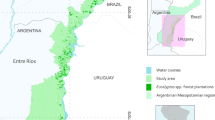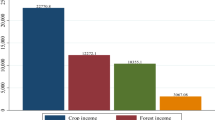Abstract
Achieving regional and national goals of renewable energy production will depend on sufficient supply of biomass from private forests, the majority of which are controlled by non-industrial private forest landowners (NIPF). Considering the diversity in management objectives and changing demographic dynamics in this ownership group, it is important to understand the characteristics of landowners that may supply woody biomass. This study developed linear discriminant analysis (LDA) and classification tree (CT) models to examine the characteristics and motivation of such NIPF landowners. Thirteen combinations of CT variable selection and split-point selection models were used in conjunction with LDA. The “importance of income” from a woody biomass harvest was the most important factor influencing NIPF landowners’ decisions in supplying woody biomass. Another significant interrelated variable was “farmer or non-farmer” forestland ownership, which was also related with “years of residency”, “availability of a multi-management plan,” and “ownership of multi-tracts of land.” CT models provided higher-level explanatory information when compared with LDA models. Study findings provide useful insight for land managers, wood procurement managers, and policy-makers in identifying the landowner groups with interest in biomass supply, and in understanding the factors influencing their decisions.



Similar content being viewed by others
References
Abt KL, Winter SA, Huggett RJJ (2002) Local economic impacts of forests. In: Wear DN, Greis JG (eds) Southern forest resource assessment, Gen. Tech. Rep. SRS-53. US Department of Agriculture, Forest Service, Southern Research Station, Asheville
Alavalapati JRR, Lal P, Susaeta A, Abt RC, Wear DN (2013) Forest biomass-based energy. In: Wear DN, Greis JG (eds) Southern Forest Futures Project. Gen. Tech. Rep. SRS-GTR-178. USDA Forest Service, Southern Research Station, Asheville
Becker DR, Eryilmaz D, Klapperich J, Kilgore MA (2013) Social availability of residual woody biomass from nonindustrial private woodland owners in Minnesota and Wisconsin. Biomass Bioenergy 56(4):82–91
Bengston DN, Asah ST, Butler BJ (2010) The diverse values and motivations of family forest owners in the United States: an analysis of an open-ended question in the National Woodland Owner Survey. Small-Scale For 10(3):339–355
Brieman L, Friedman JH, Olshen RA, Stone CJ (1984) Classification and regression trees. Wadsworth, Belmont
Butler BJ, Leatherberry EC (2004) America’s family forest owners. J Forest 102(7):4–14
Conrad JL, Bolding MC, Smith RL, Aust WM (2011) Wood energy market impact on competition, procurement practices, and profitability of landowners and forest product industry in the US South. Biomass Bioenergy 35(1):280–287
Dillman D (2000) Mail and internet surveys. The tailored design method, 2nd edn. Wiley, New York
Eisenbeis RA (1977) Pitfalls in the application of discriminant analysis in business, finance, and economics. J Financ 32(3):875–900
Geisser S (1974) A predictive approach to the random effect model. Biometrika 61(1):101–107
Gregory SA, Conway MC, Sullivan J (2003) Econometric analyses of nonindustrial forest landowners: is there anything left study? J For Econ 9(2):137–164
Gronowska M, Joshi S, MacLean HL (2009) A review of US and Canadian biomass supply studies. Bioresources 4(1):341–369
Hitchner S, Schelhas J (2012) Social acceptability of biofuels among small-scale forest landowners in the US South. In: Proceedings of the IUFRO 3.08.00 small-scale forestry conference, University of Massachusetts, Amherst, 24–27 Sept 2012
Joshi O, Mehmood SR (2011) Factors influencing NIPF landowners’ willingness to supply woody biomass. Biomass Bioenergy 35(1):186–192
Joshi O, Grebner DL, Hussain A, Grado SC (2013) Landowner knowledge and willingness to supply woody biomass for wood-based bioenergy: sample selection approach. J For Econ 19(2):97–109
Kaetzel BR, Hodges DG, Houston D, Fly JM (2009) Predicting the probability for landowner participation in conservation assistance programs: a case study of the Northern Cumberland Plateau of Tennessee. South. J Appl For 33(1):5–8
Kim H, Loh WY (2001) Classification trees with unbiased multiway splits. J Am Stat Assoc 6(454):589–604
Kim H, Loh WY (2003) Classification trees with bivariate linear discriminant node models. J Comput Gr Stat 12(3):512–530
Kim H, Guess FM, Young TM (2011) An extension of regression trees to generate better predictive models. IIE Trans 43(1):43–54
Kumarappan S, Joshi S, MacLean HL (2009) Biomass supply for biofuel production: estimates for the United States and Canada. Bioresources 4(3):1070–1087
Leitch ZJ, Lhotka JM, Stainback GA, Stringer JW (2013) Private landowner intent to supply woody feedstock for bioenergy production. Biomass Bioenergy 56:127–136
Liao X, Zhang Y (2008) An econometric analysis of softwood production in the US South: a comparison of industrial and nonindustrial forest ownerships. For Prod J 58(11):69–74
Loh WY (2002) Regression trees with unbiased variable selection and interaction detection. Stat Sin 12(2):361–386
Lucia LA (2008) Lignocellulosic biomass: a potential feedstock to replace petroleum. Bioresources 4(3):1070–1087
Majumdar I, Teeter L, Butler B (2008) Characterizing family forest owners: a cluster analysis. For Sci 54(2):176–184
Measells MK, Grado SC, Hughes HG, Dunn MA, Idassi J, Zielinske B (2005) Nonindustrial private forest landowner characteristics and use of forestry services in four southern states: results from a 2002–2003 mail survey. South J Appl For 29(4):194–199
Mika S, Ratsch G, Weston J, Scholkopf B, Mullers KR (1999). Fisher discriminant analysis with kernels, neural networks for signal processing IX. In: Proceeding of conference 1999 IEEE signal processing society workshop, Copenhagen, Denmark, 41–48 1999
Moss SA, Hedderick DB (2012) An economic evaluation of a small-scale timber harvesting operation in Western Maryland, USA. Small-Scale For 11(1):101–117
Paula AL, Bailey C, Barlow RJ, Morse W (2011) Landowner willingness to supply timber for biofuel: results of an Alabama survey of family forest landowners. South J Appl For 35(2):93–97
Prestemon JP, Abt RC (2002) The southern timber market for 2040. J For 100(7):16–22
Quinlan JR, Rivest RL (1989) Inferring decision trees using the minimum description length principle. Inf Comput 80(3):227–248
Shaw J, Hazel D, Bardon R, Jayaratne KSU (2012) Landowner’ knowledge, attitudes, and aspirations towards woody biomass markets in North Carolina. J Extension 50(4):FEA9
Shivan GC, Mehmood SR (2010) Factors influencing nonindustrial private forest landowners’ policy preference for promoting bioenergy. For Policy Econ 12(8):581–588
SPSS Inc. (2007) SPSS 16.0 for Windows, Release 16.0.1, Chicago, IL
Tyndall JC, Schulte LA, Hall RB (2011) Expanding the US cornbelt biomass portfolio: forester perceptions of the potential for woody biomass. Small-scale For 10(3):287–303
Washburn MP, Jones SB, Nielsen LA (1998) Non-industrial private forest landowners: building the business case for sustainable forestry. In: Jenkins MB (ed) The business of sustainable forestry: case studies, John D. and Catherine T. MacArthur Foundation, Chicago, IL, pp 10–41
Wetcher-Hendricks D (2011) Analyzing quantitative data: an introduction for social researchers. Wiley, New York
Wicker G (2002) Motivation for private forest landowners. In: Wear DN, Greis JG (eds) Southern forest resource assessment, USDA For. Serv. Gen. Tech.Rep. SRS-53. US Department of Agriculture, Forest Service, Southern Research Station, Asheville
Author information
Authors and Affiliations
Corresponding author
Appendix A: Linear Discriminant Analysis (LDA)
Appendix A: Linear Discriminant Analysis (LDA)
LDA attempts to find linear combinations of predictor (independent) variables that best separate the groups of observations. These combinations are called discriminant functions (Mika et al. 1999). There are K functions of the form:
for the K groups, each assumed to have a multivariate normal distribution with mean vectors μ k (k = 1,…, K) and common covariance matrix ∑, ∑−1 is inverse of covariance matrix, where πk = n k /n is the proportion of group k, such that π 1 + π 2 + ··· + π k = 1. LDA classifies observations x i to the group k, which minimize the within-group variance,
where argmin stands for “argument of the minimum”, i.e. the set of points of the given argument for which the value of the given expression attains its minimum. LDA has two potential limitations: (a) there must be a statistical significant difference in the mean vectors between groups, and (b) the number of observations in each group must be greater than the number of predictors or independent variables (Eisenbeis 1977). Linear discriminant functions were estimated using SPSS v16.0 (SPSS Inc. 2007).
Two methods were used for validation of the LDA model results. Re-substitution was used which applies the discriminant model to the original training data set to observe the frequency of correctly classified observations. The other method used was q-fold cross-validation (Geisser 1974). For q-fold cross-validation, the original sample is partitioned into q subsamples. A single subsample is retained for validation of the model built from the other q-1 subsamples. The process is repeated q times, with each of the q subsamples used exactly once for validation. The results of the q time iterations are combined to produce a single classification rate estimate.
Classification Trees (CT)
CT methods are elements of decision tree (DT) methodology (Quinlan and Rivest 1989). A DT is a decision tool that uses a graph of a model of decisions and possible outcomes. CTs are used for modeling and predicting categorical response variables from a set of continuous predictors, categorical predictors or both. CTs are promising classification methods because of their simple interpretation, high classification accuracy, and ability to characterize complex interactions among variables (Brieman et al. 1984).
In general, CTs build decision rules by recursive binary or multi-way partitioning of the data space into subspaces that are increasingly homogeneous with respect to the class variable. The homogeneous regions are called nodes. At each step in fitting a CT, an optimization is carried out to select a node, a predictor variable, and a split-point for numeric variables or categorical variables that result in the most homogeneous subgroups for the data (Brieman et al. 1984).
In CTs, selection bias is one of the most important issues. Two sources of bias are: (a) when variables differ significantly in their numbers of splits, and (b) when variables differ in their proportions of missing values. CRUISE (Classification Rule with Unbiased Interaction Selection and Estimation) was used in this analysis (Kim and Loh 2001; Loh 2002; Kim and Loh 2003). CRUISE methods minimize selection bias. CRUISE uses two techniques to improve the interpretability of its trees (Kim et al. 2011). First, it splits each node into multiple subnodes, with one for each class; this reduces CT depth. Second, it selects variables based on one-factor and two-factor effects, therefore immediately identifying variables with significant interactions. V-fold cross-validation was used to validate the CT models. In v-fold cross-validation, a tree of the specified size is computed v times, each time leaving out one of the sub-samples from the computations, and using that sub-sample as a test sample for v-fold cross-validation. Each sub-sample is used (v − 1) times in the training sample and just once as the validation test sample (Brieman et al. 1984).
Rights and permissions
About this article
Cite this article
Young, T., Wang, Y., Guess, F. et al. Understanding the Characteristics of Non-industrial Private Forest Landowners Who Harvest Trees. Small-scale Forestry 14, 273–285 (2015). https://doi.org/10.1007/s11842-015-9287-9
Accepted:
Published:
Issue Date:
DOI: https://doi.org/10.1007/s11842-015-9287-9




